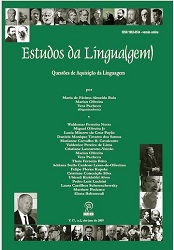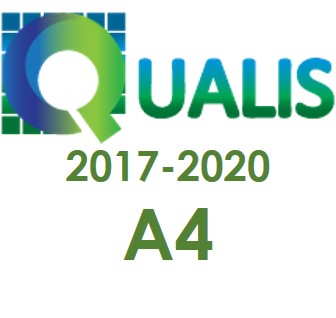L2 development and L1 attrition in an L1-dominant environment: analysing voice onset time in L1 Spanish and L2 English
DOI:
https://doi.org/10.22481/el.v17i2.5345Keywords:
L1 attrition; Voice Onset Time; Language as a Complex, Dynamic System; Spanish; English as a Second Language.Abstract
In this study, we investigate the occurrence of L1 attrition among Argentinean learners of English (L2) living in their home country, which constitutes an L1-dominant environment. We analyzed the production of Voice Onset Time in word-initial plosives in L1 Spanish by monolingual and bilingual participants. We carried out both an inferential analysis and an individual verification of each participant’s production, which proved to be complementary. Our results suggest that not only is the L2 affected by the L1, but also the L1 can be modified in view of the contact with additional languages.
Downloads
References
ALVES, Mariane Antero. Estudo dos parâmetros acústicos relacionados à produção das plosivas do português brasileiro na fala adulta: análise acústico-quantitativa. Tese (Doutorado em Linguística). Florianópolis: Universidade Federal de Santa Catarina, 2015.
ALVES, Ubiratã Kickhöfel. Sobre los efectos del desarrollo fonético-fonológico de L2 em el sistema de lengua materna: una discusión a partir de datos de VOT. Proceedings of the V Jornadas Internacionales de Fonética y Fonología I Jornadas Internacionales de Fonología y Discurso. La Plata (Buenos Aires, Argentina), in press.
_____. LUCHINI, Pedro Luis. Effects of perceptual training on the identification and production of word-initial voiceless stops by Argentinean learners of English. Ilha do Desterro, v. 70, n. 3, p. 15-32, 2017.
BECKNER, Clay; ET AL. Tom. Language is a Complex Adaptive System - Position Paper. Language Learning, v. 59, supl. 1, p. 1-26, 2009.
BEST, Catherine. A direct realist view of cross-language speech perception. In: STRANGE, Winifred (ed.). Speech Perception and Linguistic Experience: theoretical and methodological issues in cross-language speech research. Timonium: York Press, 1995, p. 167-200.
_____; TYLER, Michael D. Nonnative and second-language speech perception: commonalities and complementarities. In: BOHN, Ocke-Schwen; MUNRO, Murray J. Language Experience in Second Language Speech Learning: In honor of James Emil Flege. Amsterdam/Philadelphia: John Benjamins Publishing Company, 2007, p. 13-34.
BOERSMA, Paul; WEENINK, David. Praat: doing phonetics by computer – version 6.0.40. 2018. Disponível em www.praat.org.
CHANG, Charles B. Rapid and multifaceted effects of second-language learning on first-language speech production. Journal of Phonetics, v. 40, p. 249-268, 2012.
DE BOT, Kees. Epilogue. In: VERSPOOR, Marjolijn; de BOT, Kees; LOWIE, Wander (eds.). A Dynamic Approach to Second Language Development: methods and techniques. Amsterdam: John Benjamins Publishing Company, 2011, p. 123-127.
_____; LOWIE, Wander; VERSPOOR, Marjolijn. A Dynamic Systems Theory approach to second language acquisition. Bilingualism: Language & Cognition, p. 7-21, 2007.
_____; THORNE, Steven; VERSPOOR, Marjolijn. Dynamic Systems Theory as a comprehensive theory of second language development. In: MAYO, María del Pilar García; MANGADO, María Junkal Gutierrez; ADRIÁN, María Martínez (eds.). Contemporary Approaches to Second Language Acquisition. John Benjamins Publishing Company, 2013, p. 199-220.
DE LEEUW, Esther. How phonetics and phonology inform L1 attrition (narrowly defined) research. Linguistic Approaches to Bilingualism 7:6, p. 725–729, 2017.
_____. Phonetic Attrition. In: SCHMID, M. S; KÖPKE, B. (Eds.) Handbook of Attrition. Oxford: Oxford University Press, 2018, p. 1-32.
_____; MENNEN, Ineke; SCOBBIE, James. Dynamic systems, maturational constraints and L1 phonetic attrition. International Journal of Bilingualism, v. 17, n. 6, p. 683-700, 2012.
FINGER, Ingrid; ORTIZ-PREUSS, Elena. A psicolinguística do bilinguismo: estudando o processamento linguístico e cognitivo bilíngue. In: ORTIZ-PREUSS, Elena; FINGER, Ingrid (orgs). A dinâmica do processamento bilíngue. Campinas: Pontes Editores, 2018, p. 31-57.
FLEGE, James E. The production of “new” and “similar” phones in a foreign language: Evidence for the effect of equivalence classification. Journal of Phonetics, 15, p. 47-65, 1987.
_____. Second Language Speech Learning: Theory, Findings, and Problems. In: STRANGE, W. (ed.) Speech perception and linguistic experience: issues in cross language research. Timonium, MD: York press, 1995, p. 233-277.
_____. Assessing constraints on second-language segmental production and perception. In: MEYER, A.; SCHILLER, N. (eds). Phonetics and Phonology in Language Comprehension and Production, Differences and Similarities. Berlin: Mouton de Gruyter, 2003, p. 319-355.
_____. Language contact in bilingualism: Phonetic system interactions. In: COLE, J.; HUALDE. J. (Eds.), Laboratory phonology, 9. Berlin, Ger.: Walter de Gruyter, 2007, p. 353-382.
GROSJEAN, François. Neurolinguists, beware! The bilingual is not two monolinguals in one person. Brain and Language, 1989, 36(1), p. 3–15, 1989.
_____. A psycholinguistic approach to code-switching: The recognition of guest words by bilinguals. One speaker, two languages: Cross-disciplinary perspectives on codeswitching, p. 259-275, 1995.
_____. Bilingual and monolingual language modes. In C. Chapelle (Ed.). The Encyclopedia of Applied Linguistics. Hoboken, New Jersey: Blackwell Publishing, 2013.
_____; LI, Ping. The Psycholinguistics of Bilingualism. Malden, MA & Oxford: Wiley-Blackwell, 2006.
IBM Corp. IBM SPSS Statistics for Windows – Version 21.0. Armonk, NY: IBM Corp., 2012.
KUPSKE, Felipe Flores. Imigração, Atrito e Complexidade: a produção das oclusivas suras iniciais do Inglês e do Português por Sul-Brasileiros residentes em Londres. Tese (Doutorado em Letras). Porto Alegre: Universidade Federal do Rio Grande do Sul, 2016.
LARSEN-FREEMAN, Diane; CAMERON, Lynne. Complex Systems and Applied Linguistics. Oxford University Press, 2008.
LIMA JR., Ronaldo Mangueira. A necessidade de dados individuais e longitudinais para análise do desenvolvimento fonológico de L2 como sistema complexo. Revista Virtual de Estudos da Linguagem, v. 14, n. 27, p. 203-225, 2016a.
_____. Análise longitudinal de vogais do inglês-L2 de brasileiros. Gradus: Revista Brasileira de Fonologia de Laboratório, v.1, n.1, p. 145-176, 2016b.
LISKER, Leigh; ABRAMSON, Arthur. A cross-language study of voicing in initial stops: acoustical measurements. Word, v. 20, p. 384-422, 1964.
LOWIE, Wander. Lost in state space? Methodological considerations in Complex Dynamic Theory approaches to second language development research. In: ORTEGA, Lourdes; HAN, ZhaoHong (eds.). Complexity Theory and Language Development: in celebration of Diane Larsen-Freeman. Amsterdam: John Benjamins Publishing Company, 2017, p. 123-141.
_____; VERSPOOR, Marjolijn. Variability and variation in Second Language Acquisition orders: a dynamic reevaluation. Language Learning, v. 65, n. 1, p. 63-88, 2015.
_____; _____. Individual differences and the ergodicity problem. Language Learning, v. 69, S.1, p. 184-206, 2019.
OPITZ, Conny. Language destabilization and (re-)learning from a Complexity Theory perspective: Timescales and patterns across four studies. In: ORTEGA, Lourdes; HAN, Zhao Hong (eds.). Complexity Theory and Language Development: in celebration of Diane Larsen-Freeman. Amsterdam: John Benjamins Publishing Company, 2017, p. 163-189.
PARK, Eun Sung. Language Attrition. In: LIONTAS, John I (Ed.) The TESOL Encyclopedia of English Language Teaching. John Wiley & Sons, p. 1-12, 2018.
PEREYRON, Leticia. A produção vocálica por falantes de Espanhol (L1), Inglês (L2) e Português (L3): uma perspectiva dinâmica na (multi) direcionalidade da transferência linguística. Tese (Doutorado em Letras). Porto Alegre: Universidade Federal do Rio Grande do Sul, 2017.
PEROZZO, Reiner Vinicius. Sobre as esferas cognitiva, acústico-articulatória e realista indireta da percepção fônica não-nativa: para além do PAM-L2. Tese (Doutorado em Letras). Porto Alegre: Universidade Federal do Rio Grande do Sul, 2017
SCHERESCHEWSKY, Laura Castilhos. O atrito linguístico sobre os padrões de VOT do Português: efeitos do Inglês (L2) e do Alemão (L3) em aprendizes bilíngues e trilíngues. Trabalho de Conclusão de Curso (Graduação em Letras) – Universidade Federal do Rio Grande do Sul, Porto Alegre, 2018.
_____; ALVES, Ubiratã Kickhöfel; KUPSKE, Felipe Flores. First language attrition: the effects of English (L2) on Brazilian Portuguese VOT patterns in an L1-dominant environment. Letrônica, v. 10, n.2, p. 700-716, 2017.
SCHMID, Monika S.; DE LEEUW, Esther. Section III Introduction 16. Linguistic factors. In: The Oxford Handbook of Language Attrition. Oxford: Oxford University Press, 2018.
_____; KOPKE, Barbara. The relevance of first language attrition to theories of bilingual development. L/inguistic Approaches to Bilingualism, v. 7, n. 6, p. 638-667, 2017.
SCHOLL, Ana Paula; FINGER, Ingrid. Elaboração de um Questionário de Histórico da Linguagem para pesquisas com bilíngues. Nonada: Letras em revista, v. 2, p. 1-17, 2013.
YAVAS, Mehmet; WILDERMUTH, Renée. The effects of place of articulation and vowel height in the acquisition of English aspirated stops by Spanish speakers. International Review of Applied Linguistics in Language Teaching, v. 44, n.3, p. 251-263, 2006.
Downloads
Published
How to Cite
Issue
Section
License

Estudos da Língua(gem) is licensed under a Creative Commons Attribution 4.0 International License.
Authors who publish in the journal Estudos da Língua (gem) agree with the following terms:
The journal Estudos de Língua(gem) maintains the copyrights of the contributions published. These rights include the publication of the contribution and make its content available for free through the portal.







